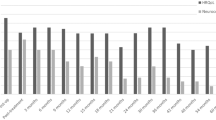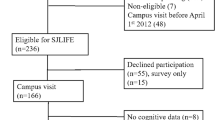Abstract
An increasing number of patients with glioblastoma multiforme live longer than 3 years after diagnosis (long-term survivors). Even so, little is known about their everyday performance and quality of life. We studied 17 glioblastoma patients surviving for longer than 3 years. We assessed all patients using the computerized neurocognitive assessment instrument NeuroCog FX test, the EORTC QLQ-C30, the EORTC QLQ-BN20, the Hospital Anxiety and Depression Scale, the Ten-Meter Walking Test, the Nine Hole Peg Test, the Boston Aphasia Severity Scale, and the Activities of Daily Living and Instrumental Activities of Daily Living forms. We included 9 female and 8 male glioblastoma long-term survivors with a median age of 51 years (24–71). The majority of the patients (10/17) scored normal in the NeuroCog FX test. However, financial difficulties, reduced social and cognitive functioning, and future uncertainty were frequently reported. Three patients showed conspicuous depression scores, two had noticeable anxiety results. Drowsiness and fatigue were the most often reported physical complaints. There were 12/17 patients who were fully independent concerning activities of daily living and 14 patients (82%) showed ≥90 points in the Barthel Index, but 6 patients (35%) were impaired in their manual dexterity, and 1 patient in mobility. Glioblastoma long-term survivors show moderate impairment in their cognitive functions and more often neurological symptoms. However, the majority of these patients are able to manage their daily routine independently. Nevertheless, future prospects remain poor and patients suffer from financial difficulties.



Similar content being viewed by others
References
Das P, Puri T, Jha P et al (2011) A clinicopathological and molecular analysis of glioblastoma multiforme with long-term survival. J Clin Neurosci 18:66–70
Deb P, Sharma MC, Mahapatra AK et al (2005) Glioblastoma multiforme with long term survival. Neurol India 53:329–332
Scott JN, Rewcastle NB, Brasher PM et al (1999) Which glioblastoma multiforme patient will become a long-term survivor? A population-based study. Ann Neurol 46:183–188
Yukihiko S, Toshihiro K, Mika W et al (2009) Long-term survivors of glioblastoma: clinical features and molecular analysis. Acta Neurochir (Wien) 151:1349–1358
Preusser M, de Ribaupierre S, Wöhrer A, Erridge SC, Hegi M, Weller M, Stupp R (2011) Current concepts and management of glioblastoma. Ann Neurol 70:9–21
Beauchesne P, Bernier V, Carnin C et al (2010) Prolonged survival for patients with newly diagnosed, inoperable glioblastoma with 3-times daily ultrafractionated radiation therapy. Neuro Oncol 12:595–602
Stupp R, Hegi ME, Mason WP et al (2009) European Organisation for Research and Treatment of Cancer Brain Tumour and Radiation Oncology Groups; National Cancer Institute of Canada Clinical Trials Group: Effects of radiotherapy with concomitant and adjuvant temozolomide versus radiotherapy alone on survival in glioblastoma in a randomized phase III study: 5-year analysis of the EORTC-NCIC trial. Lancet Oncol 10:459–466
Wöhrer A, Waldhör T, Heinzl H et al (2009) The Austrian Brain Tumour Registry: a cooperative way to establish a population-based brain tumour registry. J Neurooncol 95:401–411
Pelletier G, Verhoef MJ, Khatri N et al (2002) Quality of life in brain tumor patients: The relative contributions of depression, fatigue, emotional distress, and existential issues. J Neurooncol 57:41–49
Hilverda K, Bosma I, Heimans JJ et al (2010) Cognitive functioning in glioblastoma patients during radiotherapy and temozolomide treatment: initial findings. J Neurooncol 97:89–94
Mukand JA, Blackinton DD, Crincoli MG et al (2001) Incidence of neurologic deficits and rehabilitation of patients with brain tumors. Am J Phys Med Rehabil 80:346–350
Taphoorn MJ, van den Bent MJ, Mauer ME et al (2007) European Organisation for Research and Treatment of Cancer: health-related quality of life in patients treated for anaplastic oligodendroglioma with adjuvant chemotherapy: results of a European Organisation for Research and Treatment of Cancer Randomized Clinical Trial. J Clin Oncol 25:5723–5730
Taphoorn MJ, Klein M (2004) Cognitive deficits in adult patients with brain tumours. Lancet Neurol 3:159–168
Wefel JS, Cloughesy T, Zazzali JL et al (2011) Neurocognitive function in patients with recurrent glioblastoma treated with bevacizumab. Neuro Oncol 13:660–668
Hottinger AF, Yoon H, DeAngelis LM et al (2009) Neurological outcome of long-term glioblastoma survivors. J Neurooncol 95:301–305
Fazeny-Dörner B, Gyries A, Rössler K et al (2003) Survival improvement in patients with glioblastoma multiforme during the last 20 years in a single tertiary-care center. Wien Klin Wochenschr 115:389–397
Hoppe C, Fliessbach K, Schlegel U et al (2009) NeuroCog FX: computerized screening of cognitive functions in patients with epilepsy. Epilepsy Behav 16:298–310
Aaronson NK, Ahmedzai S, Bergman B et al (1993) The European Organisation for Research and Treatment of Cancer QLQ-C30. A quality-of-life instrument for use in international clinical trials in oncology. J Natl Cancer Inst 85:365–376
Bottomley A, Vanvoorden V, Flechtner H et al (2003) The challenge and achievements of implementation of quality of life research in cancer clinical trials. Eur J Cancer 39:275–285
Taphoorn MJ, Claassens L, Aaronson NK et al (2010) EORTC Quality of Life Group, and Brain Cancer, NCIC and Radiotherapy Groups: an international validation study of the EORTC brain cancer module (EORTC QLQ-BN20) for assessing health-related quality of life and symptoms in brain cancer patients. Eur J Cancer 46:1033–1040
Zigmond AS, Snaith RP (1983) The hospital anxiety and depression scale. Acta Psychiatr Scand 67:361–370
Herrmann C (1997) International experiences with the hospital anxiety and depression scale—a review of validation data and clinical results. J Psychosom Res 42:17–41
Grant R, Slattery J, Gregor A et al (1994) Recording neurological impairment in clinical trials of glioma. J Neurooncol 19:37–49
Boston Diagnostic Examination Booklet. Les and Febiger, Philadelphia
Clyde Z, Chataway SJ, Signorini D et al (1998) Significant change in tests of neurological impairment in patients with brain tumors. J Neurooncol 39:81–90
Schwarz R, Hinz A (2001) Reference data for the quality of life questionnaire EORTC QLQ-C30 in the general German population. Eu J Cancer 37:1345–1351
Taphoorn MJ, Sizoo EM, Bottomley A (2010) Review on quality of life issues in patients with primary brain tumors. Oncologist 15:618–626
Hassler MR, Elandt K, Preusser M et al (2010) Neurocognitive training in patients with high-grade glioma: a pilot study. J Neurooncol 97:109–115
Scoccianti S, Magrini SM, Ricardi U et al (2010) Patterns of care and survival in a retrospective analysis of 1059 patients with glioblastoma multiforme treated between 2002 and 2007: a multicenter study by the Central Nervous System Study Group of Airo (Italian Association of Radiation Oncology). Neurosurgery 67:446–458
Poelen J, Prick MJ, Jeuken JW et al (2009) Six year survival after prolonged temozolomide treatment in a 30-year-old patient with glioblastoma. Acta Neurol Belg 109:238–242
Herman MA, Tremont-Lukats I, Meyers CA et al (2003) Neurocognitive and functional assessment of patients with brain metastases: a pilot study. Am J Clin Oncol 26:273–279
Ek L, Almkvist O, Wiberg MK et al (2010) Early cognitive impairment in a subset of patients with presumed low-grade glioma. Neurocase 16:503–511
Jalali R, Mallick I, Dutta D et al (2010) Factors influencing neurocognitive outcomes in young patients with benign and low-grade brain tumors treated with stereotactic conformal radiotherapy. Int J Radiat Oncol Biol Phys 77:974–979
Sheline GE, Wara WM, Smith V (1980) Therapeutic irradiation and brain injury. Int J Radiat Oncol Biol Phys 6:1215–1228
Crossen JR, Garwood D, Glatstein E et al (1994) Neurobehavioral sequelae of cranial irradiation in adults: a review of radiation-induced encephalopathy. J Clin Oncol 12:627–642
Armstrong CL, Gyato K, Awadalla AW et al (2004) A critical review of the clinical effects of therapeutic irradiation damage to the brain: the roots of controversy. Neuropsychol Rev 14:65–86
Schmidinger M, Linzmayer L, Becherer A et al (2003) Psychometric- and quality-of-life assessment in long-term glioblastoma survivors. J Neurooncol 63:55–61
Steinbach JP, Blaicher HP, Herrlinger U et al (2006) Surviving glioblastoma for more than 5 years: the patient’s perspective. Neurology 66:239–242
Acknowledgments
This study is part of the doctoral thesis “Evaluation of Health-related Quality of Life in adult patients with glioblastoma multiforme and in their primary caregivers” in Austria (available at: www.meduniwien.ac.at/clins). There was no funding for this study.
Conflict of interest
The authors declare that they have no conflict of interest.
Author information
Authors and Affiliations
Corresponding author
Electronic supplementary material
Below is the link to the electronic supplementary material.
Rights and permissions
About this article
Cite this article
Flechl, B., Ackerl, M., Sax, C. et al. Neurocognitive and sociodemographic functioning of glioblastoma long-term survivors. J Neurooncol 109, 331–339 (2012). https://doi.org/10.1007/s11060-012-0897-1
Received:
Accepted:
Published:
Issue Date:
DOI: https://doi.org/10.1007/s11060-012-0897-1




